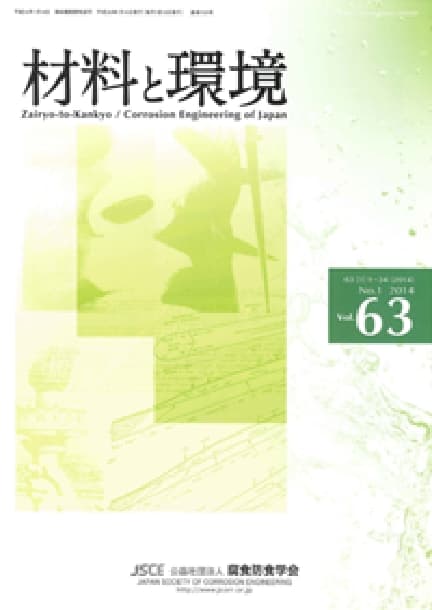- TOP
- Zairyo-to-Kankyo
- Vol. 58 (2009), No. 6
Zairyo-to-Kankyo Vol. 58 (2009), No. 6
Backnumber
-
Vol. 74 (2025)
-
Vol. 73 (2024)
-
Vol. 72 (2023)
-
Vol. 71 (2022)
-
Vol. 70 (2021)
-
Vol. 69 (2020)
-
Vol. 68 (2019)
-
Vol. 67 (2018)
-
Vol. 66 (2017)
-
Vol. 65 (2016)
-
Vol. 64 (2015)
-
Vol. 63 (2014)
-
Vol. 62 (2013)
-
Vol. 61 (2012)
-
Vol. 60 (2011)
-
Vol. 59 (2010)
-
Vol. 58 (2009)
-
Vol. 57 (2008)
-
Vol. 56 (2007)
-
Vol. 55 (2006)
-
Vol. 54 (2005)
-
Vol. 53 (2004)
-
Vol. 52 (2003)
-
Vol. 51 (2002)
-
Vol. 50 (2001)
-
Vol. 49 (2000)
-
Vol. 48 (1999)
-
Vol. 47 (1998)
-
Vol. 46 (1997)
-
Vol. 45 (1996)
-
Vol. 44 (1995)
-
Vol. 43 (1994)
-
Vol. 42 (1993)
-
Vol. 41 (1992)
-
Vol. 40 (1991)
Keyword Ranking
15 Dec. (Last 30 Days)
Zairyo-to-Kankyo Vol. 58 (2009), No. 6
High Temperature Sulfidation-corrosion and Countermeasures on Power Recovery Turbine for Oil Refinery Equipment
Hiroshi Yakuwa, Matsuho Miyasaka
pp. 214-220
DOI:
10.3323/jcorr.58.214Abstract
A Ni-base alloy, UNS N07001, is generally used for power recovery turbine rotors for fluid catalytic cracking units of oil refinery equipment (FCC gas expander turbines). However, the alloy may suffer from sulfidation-corrosion caused by H2S and SO2 contained in the FCC exhaust gas. This paper describes the problem of high-temperature sulfidation-corrosion of FCC gas expander turbine rotors and the influence of the gas composition, temperature, and stress to the grain boundary sulfidation-corrosion behavior. In addition to explanation of the fracture mechanism of the gas expander turbine blades, countermeasures against high-temperature sulfidation-corrosion are introduced: Cr diffusion coating, a steam cooling system, and a sulfidation-corrosion resistant Ni-base alloy. The Cr diffusion coating is highly dimensionally accurate allowing use on close tolerance fitting parts with complicated profiles such as blades and disks and shows high sulfidation-corrosion resistance in the operating conditions of gas expanders. The developed sulfidation-corrosion resistant Ni-base alloy for FCC gas expander turbine rotors offers high-temperature strength equivalent to the conventional alloy, UNS N07001, with higher sulfidation-corrosion resistance.
SCC Behavior at Hardened Surface Layer of 316(LC) in Water on High Temperature
Kiyoko Takeda, Akira Taniyama, Takeo Kudo, Hitoshi Uchida, Jun-ichiro Mizuki
pp. 228-233
DOI:
10.3323/jcorr.58.228Abstract
SCC behavior on hardened surface layer of 316(LC) in high temperature water was studied. The hardened surface layer was prepared by laboratory experiments. A depth profile of residual stress at the hardened surface layer was estimated using SPring-8. The results showed the residual tensile stress was more than 900 MPa at the top of surface layer where HV was about 300. SCC susceptibility was estimated by a creviced bent beam test in water containing 200 ppb SO42– and 8 ppm dissolved oxygen at 561 K. It became clear that the threshold stress of SCC for 316(LC) existed and the value was about 600 MPa in this condition. The residual tensile stress caused by surface finishing is considered to play an important role in SCC.
Relationship between Cathodic Current and Microorganism on Stainless Steel in Seawater
Naoki Washizu, Tadashi Shinohara, Shin-ichi Motoda, Jun’ichi Sakai
pp. 234-240
DOI:
10.3323/jcorr.58.234Abstract
Cathodic currents measurements and biological analysis were conducted for type 329J4L stainless steel exposed to natural seawater for the purpose of finding a factor in microbiological promotion of crevice corrosion propagation. The cathodic current density measured at 0.2 V vs. SHE rose from values below 0.1 μA/cm2 and became higher than 2 μA/cm2 in summer. However, there was no obvious rise in cathodic current densities and their values were lower than 0.1 μA/cm2 at the other seasons. 16S rRNA gene analysis revealed that bacteria belonging to Genus Algibacter or Class Gammaproteobacteria were specific to biofilms on the sample with the rise in the cathodic current density above 2 μA/cm2 in summer. The population of all kinds of bacteria did not have positive effect on cathodic currents. It is, therefore, concluded that large cathodic currents resulting in high corrosion rate are mainly induced by the action of specific bacteria, and that there is a possibility of Algibacter or Gammaproteobacteria having action to enlarge cathodic currents.
Article Access Ranking
15 Dec. (Last 30 Days)
-
Delayed Fracture Mechanism of 1700 MPa-Class Quenched and Tempered Bolt under Atmospheric Corrosion Environment
Tetsu-to-Hagané Advance Publication
-
Perspectives on the Promising Pathways to Zero Carbon Emissions in the Steel Industry toward 2050
ISIJ International Vol.65(2025), No.2
-
Effect of B on Surface Oxidation Behavior and Phosphatability of Si-Mn-added Cold-Rolled Steel Sheets
ISIJ International Advance Publication
-
Factors Influencing the Bonding Phase Structure of Iron Ore Sinters
ISIJ International Vol.43(2003), No.9
-
Effect of microstructural heterogeneity on fatigue limit of as-quenched low-carbon low-alloy martensitic steel
ISIJ International Advance Publication
-
Prussian blue as a fully reversible hydrogenochromic material for visualizing hydrogen distribution in Fe sheet
ISIJ International Advance Publication
-
Progress of Strip Casting Technology for Steel; Historical Developments
ISIJ International Vol.52(2012), No.12
-
Research Progress on Optimal Blending of Iron Ore Powders for Sintering
ISIJ International Vol.65(2025), No.12
-
-
Microstructures and Reduction Properties of High CaO Concentration Sintered Ore
ISIJ International Advance Publication
You can use this feature after you logged into the site.
Please click the button below.










